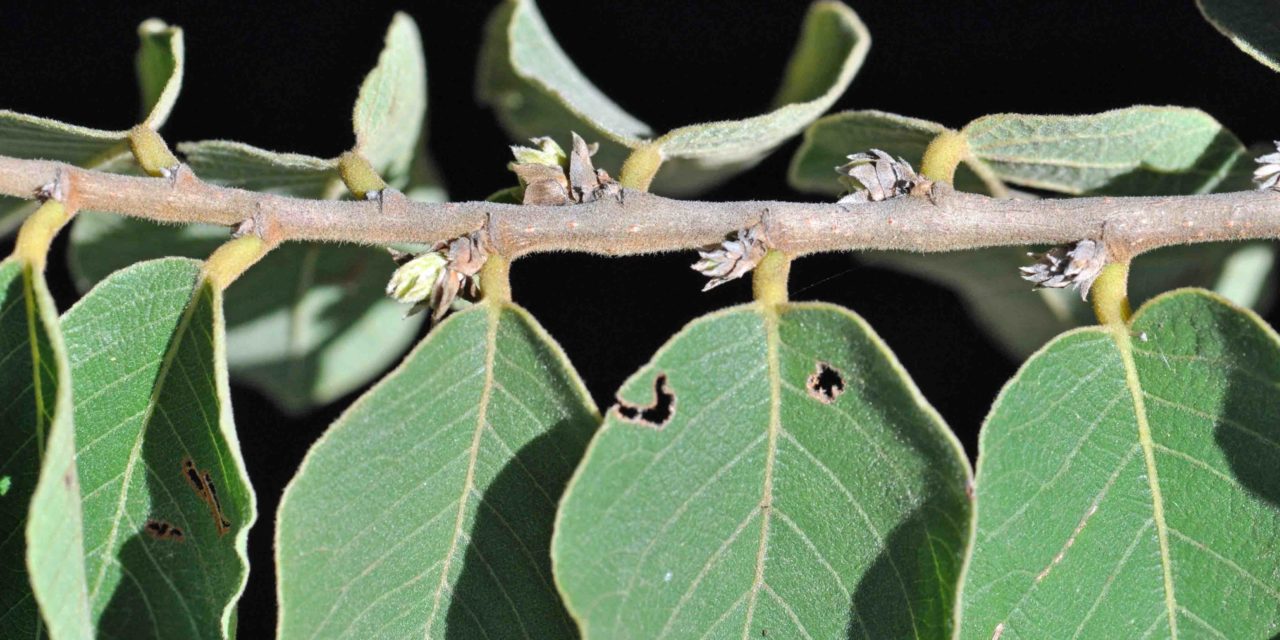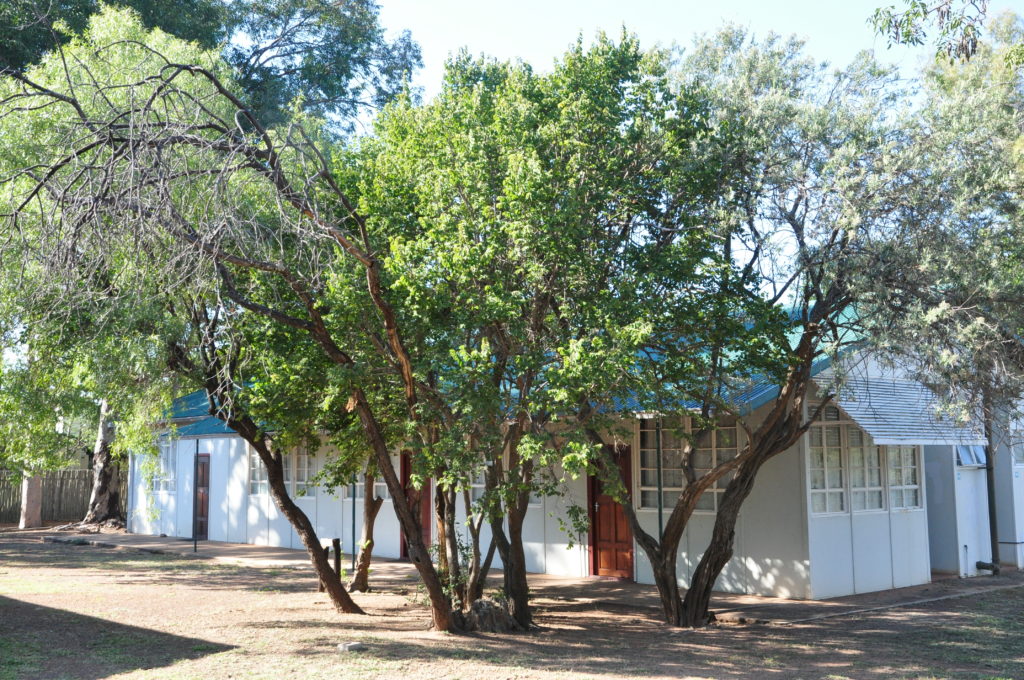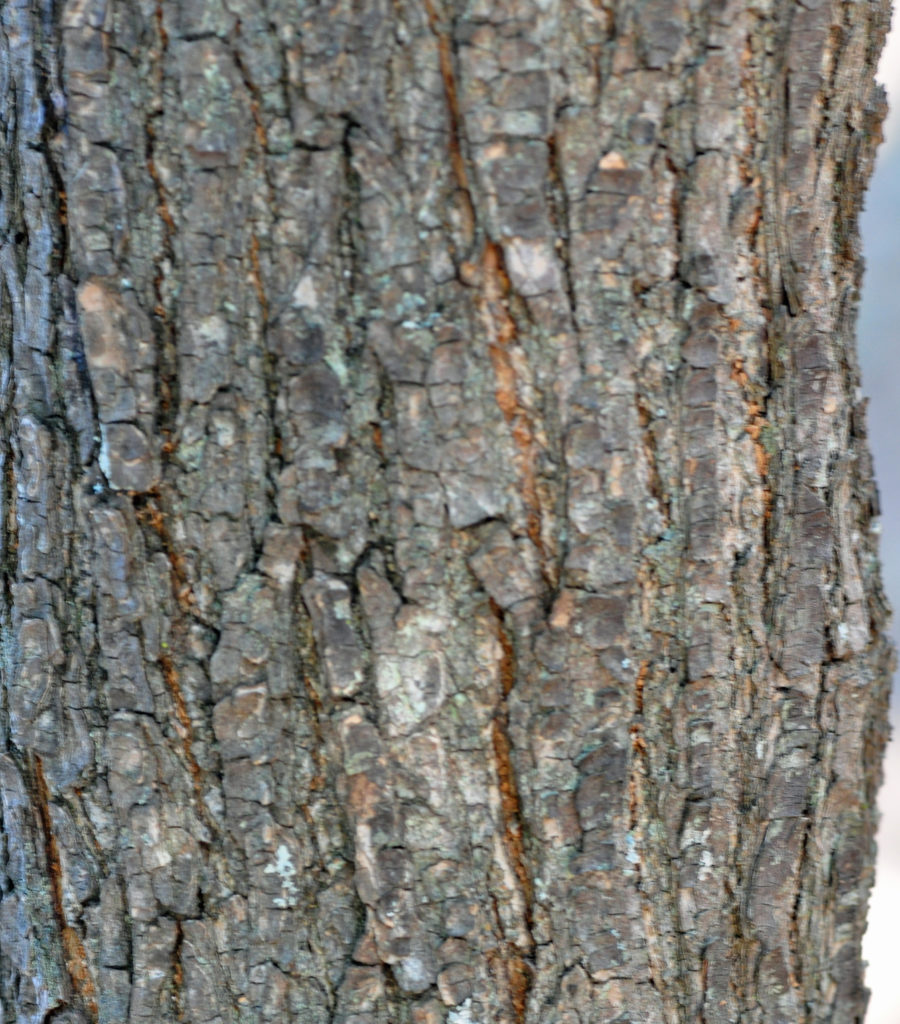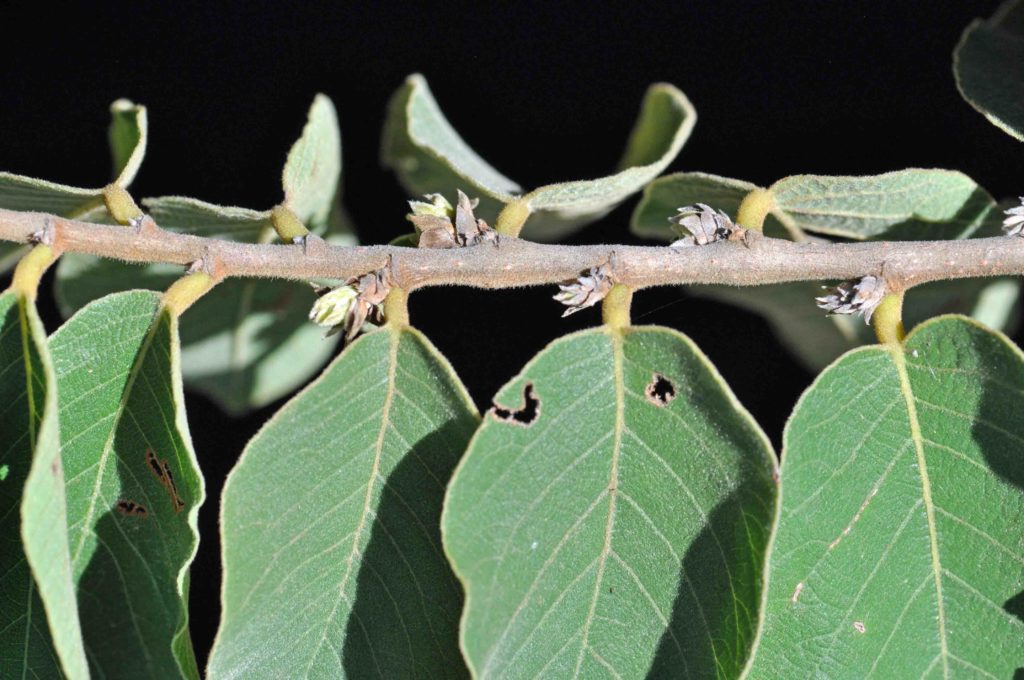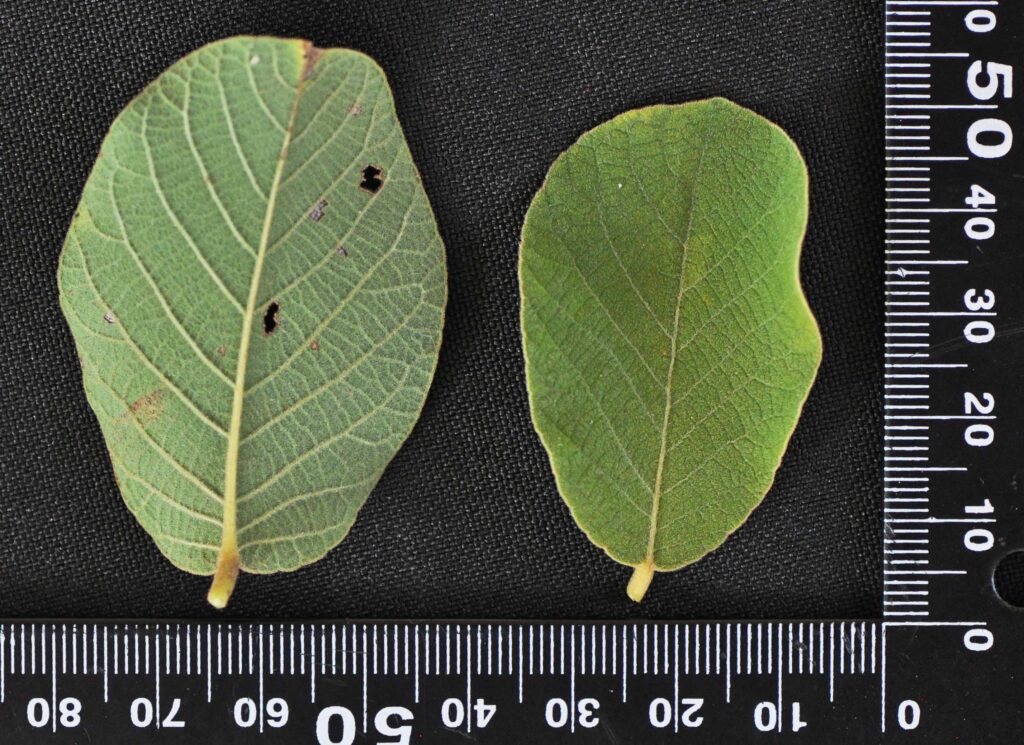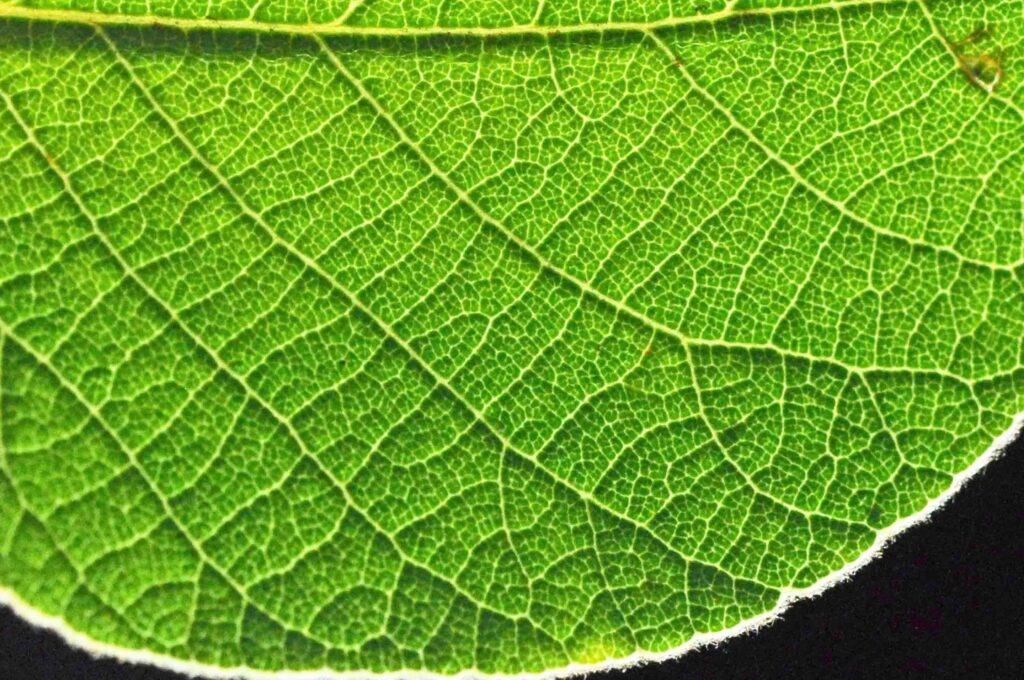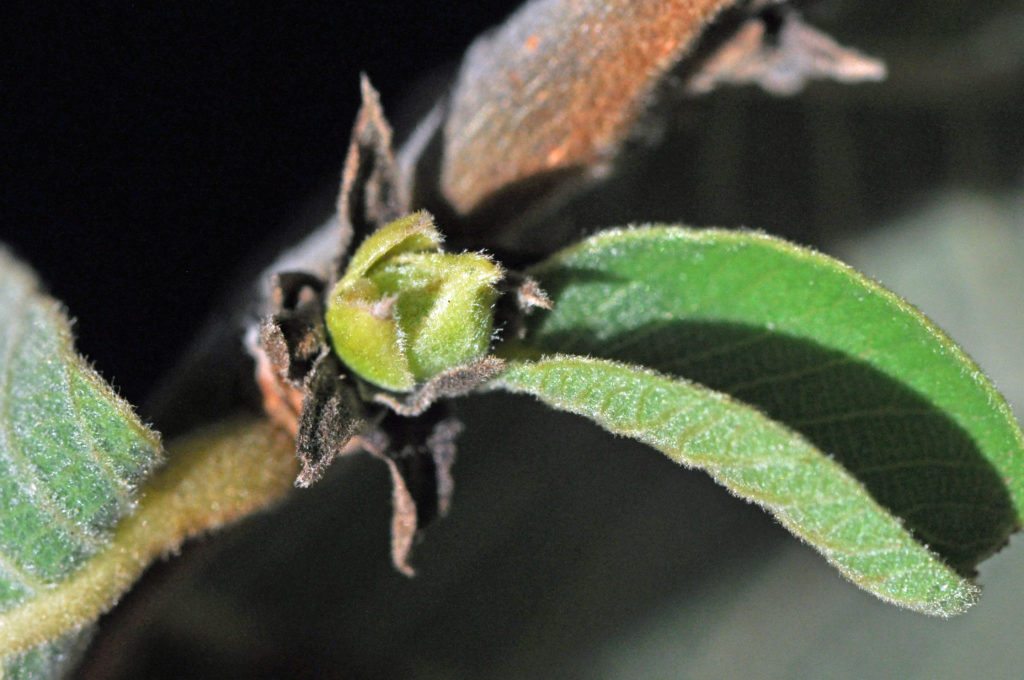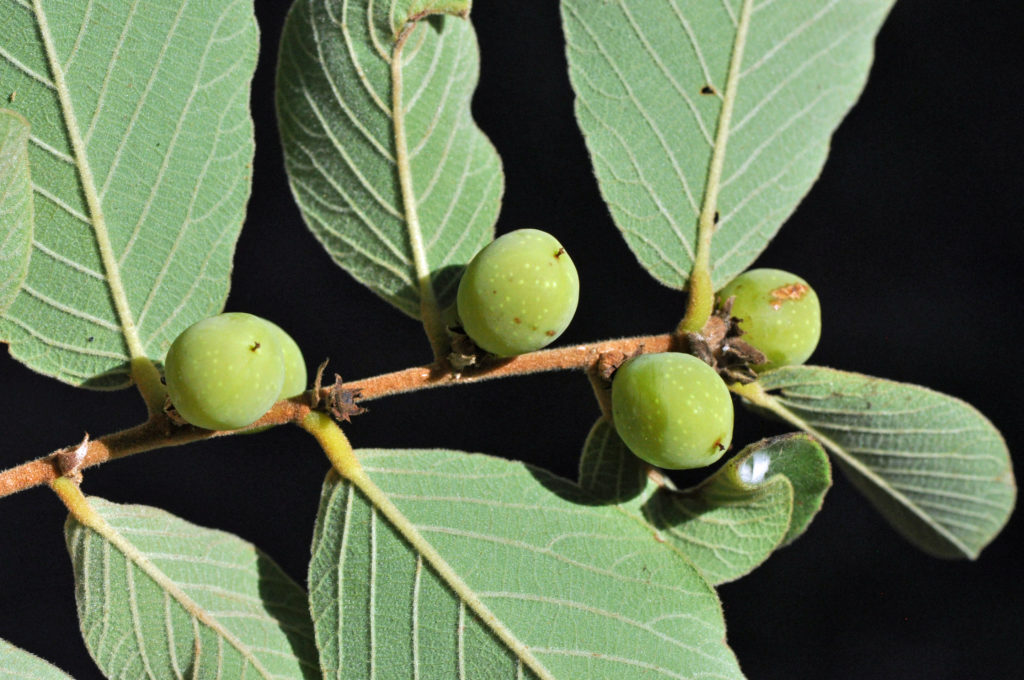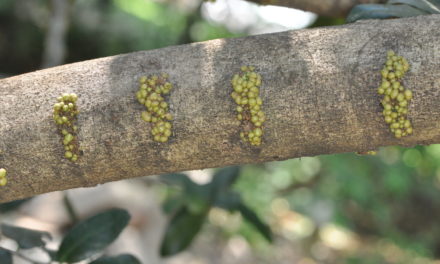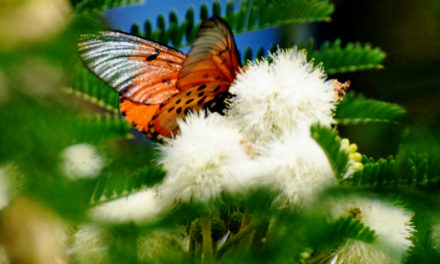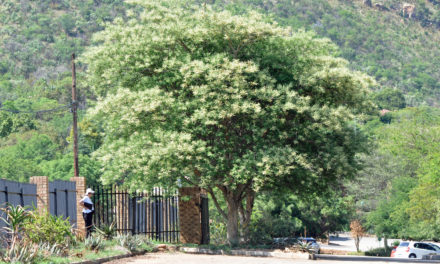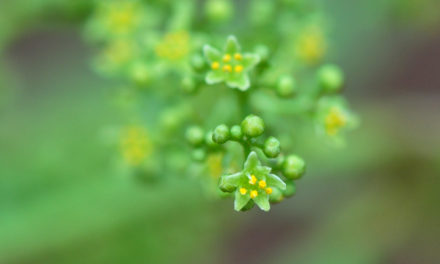General Info – summary.
This deciduous, monoecious and ornamental Tree with its greyish brown bark is up to 9m high. Twigs are velvety. Simple, densely hairy, translucent Leaves have herringbone side veins, are alternate, and have thick petioles. Small, unisexual and greenish yellow Flowers + 5 small petals. Female with a double disc & superior ovary. 5 stamens have connate filaments. Edible Fruit is a spherical berry + 1 or 2 hard seeds.
Description.
Bridelia mollis.
SA Tree No. 325.
Common names: (Afr) Fluweel-soetbessie, Wollerige Soetbessie. (Eng) Bushveld Bridelia, Velvet Bridelia, Velvet-leaved Bridelia, Velvet Sweet-berry. (Setswana) Mokamanawa, Mokokonala, Mokokonana, Mokokwele, Mokokwenana, Mokopakopa. (Tshivenda) Mukumba-kumbane. (Xitsonga) Swatima.
Family: Phyllanthaceae. In this diverse family, Latex as well as Spines are usually absent. This is diagnostic and excludes them from Euphorbiaceae. There are about 50+ genera and 2 000 species in this family. They are most numerous in the tropics and most members are trees. Leaves are usually simple, alternate and petiolate. Leaf margins are usually entire, and leaves are present in most species. The actinomorphic Flowers are usually unisexual and are monoecious or dioecious. The superior Ovary has 2 ovules in each locule. The Fruit is a berry, drupe or schizocarp. Local genera containing trees on this website include Antidesma, Bridelia, Cleistanthus and Heywoodia.
Name derivation: Bridelia – named after Samuel Elisee de Bridel (1761-1828) – a Swiss-German moss specialist. mollis – soft: referring to the velvety, hairy leaves. There are 4 species of this genus in southern Africa. All have simple, untoothed, alternate leaves.
Conservation: National Status: L C. (Least Concern). Assessment: 2005 (R.H. Archer and J.E. Victor).
Tree
This ornamental Tree has a thick, leafy, rounded crown and may reach 9m in height but is usually half this. Shoots and twigs are densely velvety (smooth, soft appearance) and are reddish to pale brown. The greyish brown, rough Bark may have longitudinal striations, exposing reddish under bark (photo 418). Present here are some Lenticels (a usually raised corky oval or elongated area on the plant that allows the uncontrolled interchange of gases with the environment).
- 418 2018/04/24 Nylsvley. Photo: David Becking.
- 416 2018/04/24 Nylsvley. Photo: David Becking.
Leaves
The large, alternate (photo 421), soft, velvety (photo 422 under Fruit) Leaves tend to droop and are simple (have a single blade which may have incisions that are not deep enough to divide the leaf into leaflets). They are ovate to obovate (egg-shaped – with the narrower end at the base – photo 419) and up to 13 x 7cm although the size may vary – even on the same branch. Leaves are light green above and slightly lighter below. Young leaves on this deciduous tree change from a furry, golden colour to a densely velvety light green as they mature. Both surfaces of the Blade are densely hairy. The Midrib is raised on both sides – more on the lower side (photo 419). There are usually between 9 and 12 almost parallel side Veins running quite steeply towards the margin forming a herringbone pattern (photo 419). These side veins reach the margins and are clearly visible on the lower surface. In this translucent leaf, all veins are clearly visible when viewed against a strong light (photo 425). Here the ladder-like smaller veins linking the side veins are visible. The Apex is rounded and possibly notched (photo 419). The Base is broadly tapering to rounded even cordate (heart-shaped) or lobed. The Margin is entire (with a continuous margin, not in any way indented) and may appear to be scalloped between veins. In photo 425, the hairy margin is visible. The Petiole (leaf stalk) is hairy, distinctly thick and short – up to 0,5cm long (photo 419). Small green stipules (basal appendages of the petiole) are present but soon fall. (Nov-Feb).
- 421 2018.04.25 Nylsvley NR. Photo: David Becking.
- 419 2018.04.25 Nylsvley NR. Photo: David Becking.
- 425 2018.04.25 Nylsvley NR. Photo: David Becking.
Flowers
The small unobtrusive greenish or reddish-yellow Flowers are up to 4mm wide. They develop in leaf axils (photo 421 – under Leaves) and are unisexual and monoecious (having both male and female reproductive organs on the same plant). Flowers are borne on short Pedicels (stalks of a single flower) in early summer. (Old flowers are visible in photo 421 – under Leaves). The 5 valvate (meeting by the edge without overlapping) Sepals are slightly longer than the petals. Unlike many members of the family, these flowers have 5 obovate Petals. Male Flowers are in short dense clusters. The 5 Stamens have filaments that are connate (united so as to form a single part). Female Flowers are fewer or are single. They have a double Disc (a more or less fleshy or elevated development of the receptacle) present. The outer disc is annular, and the inner disc surrounds the base of the superior Ovary. Here 2 locules (separate cavities in the ovary) are usually present. Each locule has 2 ovules. (Nov-Feb).
Fruit
The round and edible drupe-like Fruit is a fleshy almost spherical Berry (pulpy, indehiscent fruit like a grape or tomato). It is roughly the size of a pea and is up to 1cm wide. The berries are initially velvety (photo 422). In this photo, the remains of the calyx are still visible. Berries become discernibly clear green with white dots and have a persistent Style (photo 435) present. They turn black when mature. The Fruit may remain on the tree after the leaves have fallen. Each fruit contains either 2 hard Seeds or one by abortion. A thin pulpy layer surrounds the seeds. Seeds have copious albumen (starchy or other nutritive material surrounding the embryo). (Jan-Jun).
- 422 2018.04.25 Nylsvley NR. Photo: David Becking.
- 435 2018.04.25 Nylsvley NR. Photo: David Becking.
Distribution & Ecology
These bushveld (a sub-tropical woodland ecoregion of southern Africa) Trees are common close to water and grow at medium to low altitudes. They may also be found in sandveld (land characterized by dry sandy soil) and on granite (an igneous rock that develops underground when silica rich molten rock cools and decompose) koppies and other rocky outcrops. It is common on rocky hills like the Waterberg, Magaliesberg and Soutpansberg. Trees are indigenous in Mpumalanga, Limpopo, North-West, Botswana, Zimbabwe, Mozambique (central, north and extreme south), Zambia, Malawi and northern Namibia. It is thus Endemic (restricted to a particular geographic location) in southern Africa. Birds and animals consume the fruit.
Ethnobotany
The edible Fruit has a taste similar to that of prunes and can be used to make jam. In some parts, local people will not use the Wood for fuel, as they believe that doing so might prevent cattle from producing female offspring. The wood is pale brown and suitable for making ornaments. It takes a good polish. Plant extracts have some Antibacterial properties. Prior to planting, the seeds should be fresh and cleaned.
References
Archer, R.H. & Victor, J.E. 2005. Bridelia mollis Hutch. National Assessment: Red List of South African Plants version 2020.1. Accessed on 2022/10/29.
Boon, R. 2010. Pooley’s Trees of eastern South Africa. Flora and Fauna Publications Trust, Durban.
Coates Palgrave, M. 2002. Keith Coates Palgrave Trees of Southern Africa, edn 3. Struik, Cape Town.
Palmer, E. & Pitman, N. 1972. Trees of southern Africa. Balkema, Amsterdam, Cape Town.
Schmidt, S. Lotter, M. & McCleland, W. 2002. Trees and Shrubs of Mpumalanga and the Kruger National Park. Jacana, Johannesburg.
van Wyk, B. & van Wyk, P. 1997 Field guide to Trees of Southern Africa. Struik, Cape Town.
http://posa.sanbi.org/flora/browse.php?src=SP
https://www.hindawi.com/journals
https://www.zimbabweflora.co.zw/speciesdata/species.php?species_id=134710
https://plants.jstor.org/compilation/Bridelia.mollis
http://citeseerx.ist.psu.edu/viewdoc/download?doi=10.1.1.828.3095&rep=rep1&type=pdf
https://en.wikipedia.org/wiki/Bridelia_mollis

